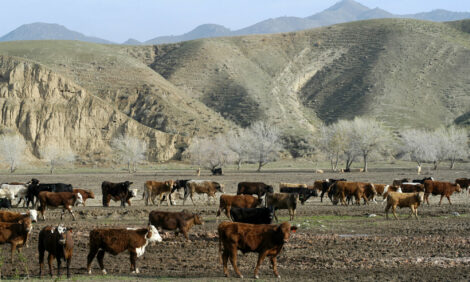



Onset 5 IN intranasally administered vaccine introduced
US - Intervet/Schering-Plough Animal Health has announced the availability of Onset 5 IN, the first intranasally administered, five-way modified-live virus vaccine for healthy cattle 3 to 8 days and older.Onset 5 IN is designed to stimulate at the site of infection an immune response to Bovine Virus Diarrhea (BVD) Type 1 and Type 2, Infectious Bovine Rhinotracheitis (IBR), Parainfluenza3 (PI3) and Bovine Respiratory Syncytial Virus (BRSV) –- the costliest diseases impacting beef and dairy herds.
Start life right
"Onset 5 IN is changing the way the beef and dairy industries think about the immune development of calves and, subsequently, the ability to help beef and dairy calves get off to a strong immunological life," says Dr. Scott Nordstrom, manager of veterinary technical services for Intervet.
"The bovine fetus has a much more mature immune system than originally believed," Nordstrom said. "In fact, the immune system of the fetus is functional at approximately 170 days of gestation. We’ve also learned that development of the immune system is independent of antibody production, meaning the immune system can respond to an appropriately-delivered vaccine without antibody interference. This knowledge underpins the developmental science of Onset 5 IN and is why the intranasal route of administration of Onset 5 IN is so important."
Why intranasal administration?
Until recently, immunology models were based on research conducted in mice, which have a different type of immune development. New research specific to the bovine immune system shows a more effective and rapid immune response can safely be generated when the vaccine is delivered to mucosal surfaces, such as the nasal mucosa, even in the youngest animals.
This is why Onset 5 IN is delivered through the nose. Intranasal vaccination more closely mirrors the route of real-world infection: More than 95% of disease-causing agents enter through the nose, causing primary respiratory disease and often secondary infections. The intranasal administration of Onset 5 IN allows for a more rapid immune response. The vaccine is delivered straight to the mucosal surfaces where infection occurs rather than taking a systemic route.
Emerging science shows vaccine delivery to the mucosal surface also may be an effective strategy for avoiding maternal antibody interference (protection passed to the calf from the dam’s milk that can prevent an immune response to vaccination). Research shows if the newborn calf’s immune system is stimulated properly by targeting the appropriate mucosal surfaces, a response will be initiated regardless of maternal antibody presence.
"Studies prove even the youngest animals can demonstrate a significant immune response when vaccines were delivered to the appropriate mucosal sites," Nordstrom says. "Onset 5 IN is targeted directly to the appropriate mucosal sites, delivering direct contact between nasal mucosa and respiratory lymph tissues and the vaccine antigens. The result: A fast and safe opportunity to protect young calves and high-stress animals from the five major respiratory diseases."
Intranasal administration of Onset 5 IN is a less stressful form of vaccine administration.
Nordstrom adds: "You’re basically achieving the same objective as a subcutaneous vaccination, but without the injection."
Proven efficacious and safe
Extensive research trials on the efficacy of Onset 5 IN vaccine demonstrate Onset 5 IN is an aid in the prevention of respiratory disease caused by BVD Type 1 and Type 2 and aids in the control of respiratory disease caused by IBR, BRSV and PI3 in neonatal calves 3 to 8 days of age or older.
"The efficacy work that was done to obtain approval of Onset 5 IN clearly indicates the neonatal immune system is capable of responding to mucosal vaccination and resisting subsequent challenge," Nordstrom said.
"The safety and efficacy trials also revealed two very interesting and positive side effects. We learned that intranasal administration shuts down viral shedding and has no impact on the white blood cell count or platelets of the animal."
Beef and dairy cattle applications
Onset 5 IN is designed for use in both dairy and beef cattle. The vaccine was uniquely developed to address the immune challenges of the most at-risk groups of cattle – newborns (at 3 days of age) and animals under high stress, such as weaned calves and new arrivals post-transport.
For dairy operations, Onset 5 IN may be utilized for newborns and calves entering calf ranches or heifer-grower operations; pre-weaning before leaving the calf hutch; in the face of disease outbreak or impending transportation stressors; in fresh cows; and as a preventive measure pre-shipment.
For beef operations, Onset 5 IN may be utilized for calves 3 to 8 days of age and older; at branding or weaning; upon arrival of stocker and feeder cattle to induce a rapid immunological response in the face of high stress, and as a preventive measure pre-shipment.
Onset 5 IN is available in 5-, 10- and 50-dose presentations and features a unique glyceride-based BluShadow® diluent that aids in the retention of the vaccine on nasal mucosa. Vaccination consists of a 2-mL dose into one nostril or 1-mL administration into each nostril.
Immunologic improvements
"The launch of Onset 5 IN represents the future of respiratory disease protection," Nordstrom says. "This technology provides alternative approaches to high-stress cattle, a better understanding of the opportunity to prime the immune system of even the youngest animals and rapid respiratory protection in the face of an outbreak."
Onset 5 IN is available through veterinarians or animal health suppliers. For more information about Onset 5 IN and the full line of Intervet/Schering-Plough Animal Health cattle products, contact Intervet customer service at 1-800-441-8272 or visit www.intervetusa.com.
| TheCattleSite News Desk | More MSD Animal Health News |



